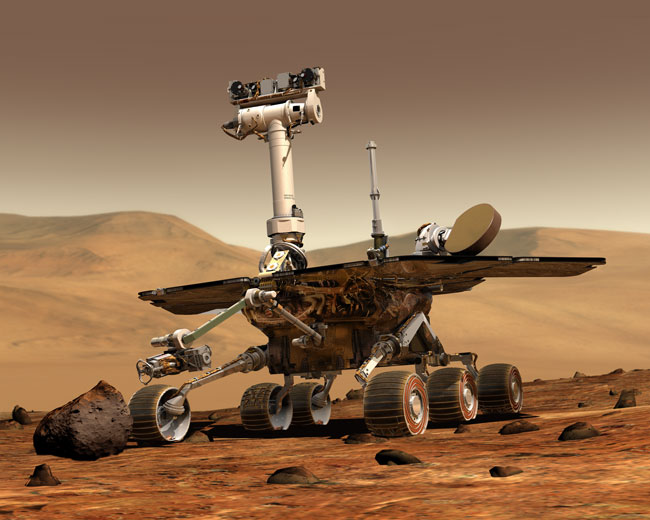
NASA's venerable Mars rover Opportunity has overcome a glitch that put the robot into standby mode late last month, agency officials announced today (May 1).
"The Opportunity rover is back under ground control, executing a sequence of commands sent by the rover team," NASA officials wrote in a mission update today. "Opportunity is no longer in standby automode and has resumed normal operations."
Opportunity apparently put itself into standby automode — in which it maintains power balance but waits for instructions from the ground — on April 22, after sensing a problem during a routine camera check, mission officials said.
The nine-year-old rover's handlers didn't notice the problem until April 27, when Opportunity got back in touch after a nearly three-week communications moratorium imposed because Mars and Earth were on opposite sides of the sun from each other.
This planetary alignment, known as a Mars solar conjunction, occurs every 26 months and affects all spacecraft operating at the Red Planet. The sun can damage or degrade signals sent from Earth, so mission controllers generally stop commanding Mars rovers, orbiters and landers for a spell.
Opportunity's controllers prepared a new set of commands on April 29 designed to get things back to normal, and the fix has apparently worked.
The golf-cart-size Opportunity rover landed on Mars in January 2004 along with its twin, Spirit, on a three-month mission to search for signs of past water activity on the Red Planet. The two rovers found plenty of such evidence, and then kept trundling across the Red Planet. Spirit was declared dead in 2010, but Opportunity is still going strong.
Get the Space.com Newsletter
Breaking space news, the latest updates on rocket launches, skywatching events and more!
Opportunity is currently exploring a spot along the rim of Mars' Endeavour Crater that may have been capable of supporting life long ago.
To date, the rover has covered 22.15 miles (35.65 kilometers) on Mars — just off the record for greatest distance traveled on the surface of another world by a robot. The Soviet Union's Lunokhod 2 rover covered 23 miles (37 km) on the moon in 1973.
Follow Mike Wall on Twitter @michaeldwall and Google+. Follow us @Spacedotcom, Facebookor Google+. Originally published on SPACE.com.
Join our Space Forums to keep talking space on the latest missions, night sky and more! And if you have a news tip, correction or comment, let us know at: community@space.com.

Michael Wall is a Senior Space Writer with Space.com and joined the team in 2010. He primarily covers exoplanets, spaceflight and military space, but has been known to dabble in the space art beat. His book about the search for alien life, "Out There," was published on Nov. 13, 2018. Before becoming a science writer, Michael worked as a herpetologist and wildlife biologist. He has a Ph.D. in evolutionary biology from the University of Sydney, Australia, a bachelor's degree from the University of Arizona, and a graduate certificate in science writing from the University of California, Santa Cruz. To find out what his latest project is, you can follow Michael on Twitter.









